- Mission Statement
- Background
- Henslow's Sparrow Report
- Objectives and Justification
- Partners in Flight High Priority Species
- General Vegetation Types and Data Sheets
- Size of Grassland
- Establishing Line Transects
- Sample Field Map
- Avian Surveys
- Vegetation Sampling
- JIZZ Descriptions and Species Codes
- Grassland Species in A.O.U. Check-list Order
- Suggested Reading
- Liability
- Acknowledgements and Miscellaneous
- Project Prairie Birds Release of Liability
 (PDF 271 KB)
(PDF 271 KB) - Project Prairie Birds Release of Landowner Liability
 (PDF 257 KB)
(PDF 257 KB) - Project Prairie Birds Vegetation Data Sheet
 (PDF 254.8 KB)
(PDF 254.8 KB) - Project Prairie Birds Bird Survey Data Sheet
 (PDF 254.9 KB)
(PDF 254.9 KB) - Project Prairie Birds Booklet without Species Photos
 (PDF 2.7 MB)
(PDF 2.7 MB)
Project Prairie Birds
A Citizen Science Project for Wintering Grassland Birds
Selected Grassland Species in A.O.U. Check-list Order

Notice: Photos are copyrighted and not available for use without express written permission of Michael L. Gray at mlgray@ppco.com.
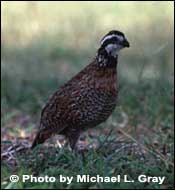
Northern bobwhite
Photo Copyright Michael L. Gray
Northern
bobwhite (Colinus
virginianus)
Alpha code: NOBO
A plump, large-bodied bird with short tail and mottled reddish-brown upperparts. Feeds in large groups (coveys) and when flushed, the group rises straight up with loud rattling wing beats. Flies only a short distance before quickly seeking shelter in high grass or brambles. Common in fields with some brush and weeds.
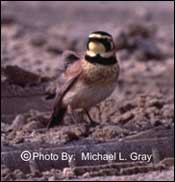
Horned lark
Photo Copyright Michael L. Gray
Horned lark (Eremophila
alpestris)
Alpha code: HOLA
Note black tail with white outer edges. Plain brown upperparts, distinctive pattern of black, white and yellow on face. Usually in groups and very rarely seen singly. Prefers bare ground or mudflats, but also occurs in short, grazed pastures.
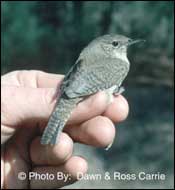
House wren
Photo Courtesy Dawn & Ross
Carrie
House wren (Troglodytes
aedon)
Alpha code: HOWR
Drab, plain brown wren with faint eyebrow. Tail often cocked. Found in thickets and brushy patches. Unlikely to fly from brush into grass when flushed; prefers to stay in thick brushy cover. Call is a harsh, thick, buzzy scold-note.
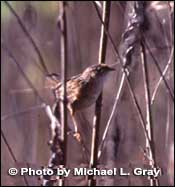
Sedge wren
Photo Copyright Michael L. Gray
Sedge wren (Cistothorus
platensis)
Alpha code: SEWR
Small short-tailed warm-brown
wren. Almost always vocalizes
just prior to and/or in
flight, giving a short,
slurred chick-chick call.
Weak flight for short distances
just above grass level,
often crashing into grass/shrub
clumps. Appears fairly dark
above with buffy-brown flanks.
Prefers moist grasslands.
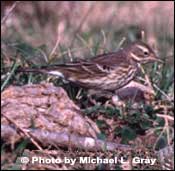
American pipit
Photo Copyright Michael L. Gray
American pipit
(Anthus rubescens)
Alpha code: AMPI
Note long black tail with
white outer tail feathers.
Upperparts uniformly grayish-brown
with no distinguishing streaks,
marks or wing bars. Often
pumps tail if perched. Commonly
found in sparsely vegetated
wet or dry fields. Usually
found in flocks (two to
hundreds of individuals
occurring together). Usually
says its name softly “pipit,
pipit” in flight.
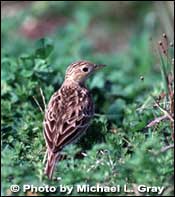
Sprague's pipit
Photo Copyright Michael L. Gray
Sprague's pipit
(Anthus spragueii)
Alpha code: SPPI
Has a dark tail and white
outer tail feathers, but
distinguished from the above
by shorter tail and by buffy-brown
upperparts that have a scaly
look and a streaked rump
sometimes visible when flushed.
This species has a prominent
dark eye, more white in
tail than the above and
does not pump tail. When
flushed, it flies high into
the air in a “stair-stepping” fashion
(unlike AMPI), spirals and
then drops down like a falling
rock back into the field.
Calls when flushed from
dry field edges and prefers
bare to mostly bare ground.
A non-flocking pipit, unlike
the above; mostly solitary.
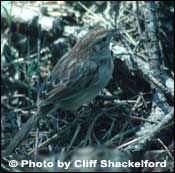
Bachman's sparrow
Photo Courtesy Cliff Shackelford
Bachman's sparrow
(Aimophila aestivalis)
Alpha code: BACS
Large rich cinnamon-colored
sparrow. More likely to
flush well before observer
is on top of bird. Strong
flier that usually flies
long distances a few feet
off the ground landing back
in the grass. A non-flocking
Pineywoods specialty.
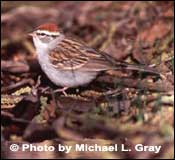
Chipping sparrow
Photo Copyright Michael L. Gray
Chipping sparrow
(Spizella passerina)
Alpha code: CHSP
A small, but long-tailed sparrow that occurs in flocks. Adults have a chestnut cap and a white eye brow. Young birds are streaked, but usually occur in the same flock as adults. A widespread generalist in winter; found in fields or forests; occurs at ground level or in canopy; attracted to urban settings (seed feeders) or far from human habitation.
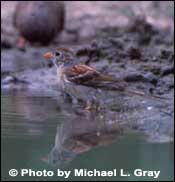
Field sparrow
Photo Copyright Michael L. Gray
Field sparrow (Spizella
Pusilla)
Alpha code: FISP
A small, pale, flocking sparrow that occurs in weedy fields. Pale eye ring, white wing bars and bright pink bill separate this species from its relatives. Has a longish tail relative to its body.
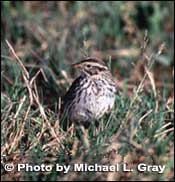
Savanna sparrow
Photo Copyright Michael L. Gray
Savannah sparrow
(Passerculus sandwichensis)
Alpha code: SAVS
Likely the most abundant and widespread wintering sparrow in the more short, sparse grassy conditions. Does not wait for a close approach before flushing. Heavily streaked all over, this sparrow has a small pinkish to flesh-colored bill and pink legs. Most individuals sport yellow lores. Sometimes perches off the ground where it’s visible after flushing, but flies fairly far on initial flush.
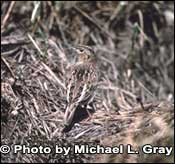
Grasshopper sparrow
Photo Copyright Michael L. Gray
Grasshopper sparrow
(Ammodramus savannarum)
Alpha code: GRSP
A rich, buffy sparrow that flushes from tall grass. Like most members of the genus, this species waits until closely approached until flushing; would rather flee by running on ground than by flying. Variable in appearance, most individuals are buffy below with some streaking or flecking on the breast. When perched, look for an even richer brown-buff in the lores and forehead.
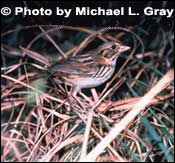
Henslow's sparrow
Photo Copyright Michael L. Gray
Henslow's sparrow
(Ammodramus henslowii)
Alpha code: HESP
Small dark rust-colored sparrow with an olive-yellow head. Reluctantly flushes only when observer is directly on top of bird. Weak flight just above grass level for short distances and often twists in flight just before crashing back into the grass or small shrub. Often pumps tail in flight.
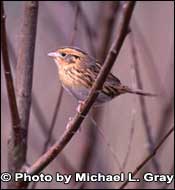
Le Conte's sparrow
Photo Copyright Michael L. Gray
Le Conte's sparrow
(Ammodramus leconteii)
Alpha code: LCSP
This “golden sparrow” appears very buffy-yellow overall. Small short-tailed sparrow with a light-to-rich gold head, a light-brown back and a light, pale belly. Often flies short distances just above grass level like other members of the genus, but may fly longer distances than HESP, but not necessarily as long as GRSP (all three can be found together in winter in the same grasslands).
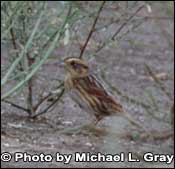
Nelson's sharp-tailed sparrow
Photo Copyright Michael L. Gray
Nelson's sharp-tailed
sparrow (Ammodramus
nelsoni)
Alpha code: NSTS
A dark yet colorful sparrow with buffy-orange facial marks; in fresh plumage, can be the most spectacular species of sparrow in North America. On the wintering grounds, it prefers areas with standing (very salty) brackish water with tall grass and reeds.
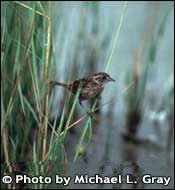
Seaside sparrow
Photo Copyright Michael L. Gray
Seaside sparrow
(Ammodramus maritimus)
Alpha code: SESP
This very dark sparrow has a very flat-headed and large-billed appearance; resident in areas with standing (very salty) brackish water with short to medium bunch grasses like Spartina species. Most individuals have a fairly bright yellow lore. After flushing, they will typically perch up on grass blades and look around. Flies straight with rapid, shallow wingbeats. Not found far from the coast.
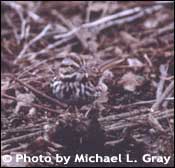
Song sparrow
Photo Copyright Michael L. Gray
Song sparrow (Melospiza
melodia)
Alpha code: SOSP
Large, dark sparrow; pumps long rounded tail in flight. Breast heavily streaked with dark breast spot and thick malar streaks. Call is a loud, frequently uttered chimp. Generally associated with at least some brushy/shrubby cover, or at least patches of thick, rank grass.
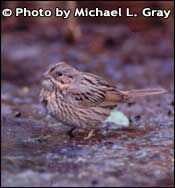
Lincoln's sparrow
Photo Copyright Michael L. Gray
Lincoln's sparrow
(Melospiza lincolnii)
Alpha code: LISP
Relatively drab-looking in flight, but may appear slightly buffy. Wings and upperparts brownish, face with wide gray eyebrow. Breast buffy with fine streaks. Utters thick, heavy tick or thick call when disturbed, as well as a raspy zeee that is louder than SWSP. Occurs in shrubby cover, including patches of brush in otherwise grassy or weedy habitats.
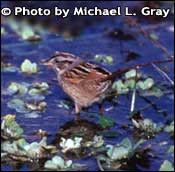
Swamp sparrow
Photo Copyright Michael L. Gray
Swamp sparrow (Melospiza
georgina)
Alpha code: SWSP
Gray face, bright rusty wings and upperparts, lightly streaked breast. Pumps tail in flight. Calls are a sharp chip and a high-pitched seee or zeee. May be found in pure grass or associated areas with shrubs. Usually does not allow a close approach. Named for its fondness of wet, grassy, often mucky areas.
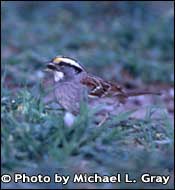
White-throated sparrow
Photo Copyright Michael L. Gray
White-throated
sparrow (Zonotrichia
albicollis)
Alpha code: WTSP
A large, thicket-loving sparrow with rich, rusty-brown streaked upperparts, gray-brown rump and long rounded tail; poorly defined wing bars and prominent white throat. Also distinctive is the streaked crown and yellow lore of adults. First winter birds are dingy and “washed out” looking with a pale white throat and heavy streaking on breast. Often flock with other thicket species in winter when they can be heard calling/singing (i.e., a loud whistle) frequently from a dense, wet thicket or field border. Usually does not occur away from the ground under shrubs, woodlands or dense thickets. Not considered a grassland species.
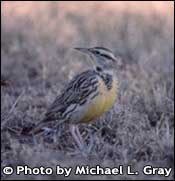
Western meadowlark
Photo Copyright Michael L. Gray
The complex of:
Eastern meadowlark
(Sturnella Magna)
Alpha code: EAME,
Western meadowlark
(Sturnella Neglecta)
Alpha code: WEME
Alpha code: MEAD
NOTE: the two meadowlarks in winter are very difficult to distinguish when not vocalizing. Numerous flocks of WEME move eastward in winter in Texas (and beyond) and occur in close proximity to EAME. It is recommended that meadowlark, species (Alpha code: MEAD) be used if species identification is not made, especially when a bird is flushed from the ground and seen briefly in flight. Do not assume that it’s an EAME just because you’re in the “eastern” part of the U.S., especially Texas. Not determining this group to the species level is totally acceptable. These are large-bodied birds with dark brown upperparts with a reddish tinge and distinctive white outer tail feathers. When flushed, flight is labored, low and of short distance with stiff glides, almost reminiscent of NOBO but with prominent white flashes in outer tail. Commonly found in pastures, agricultural fields and wet prairies. Usually in flocks, sometimes small or even large.
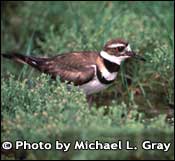
Killdeer (KILL)
Photo Copyright Michael L. Gray
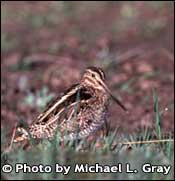
Wilson's snipe (WISN)
Photo Copyright Michael L. Gray
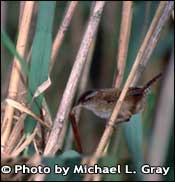
Marsh wren (MAWR)
Photo Copyright Michael L. Gray
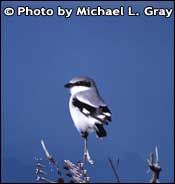
Loggerhead shrike (LOSH)
Photo Copyright Michael L. Gray
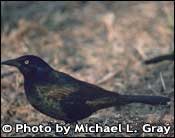
Common grackle (COGR)
Photo Copyright Michael L. Gray
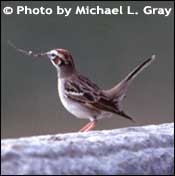
Lark sparrow
Photo Copyright Michael L. Gray
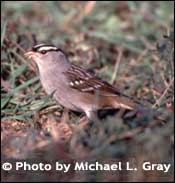
White-crowned sparrow
Photo Copyright Michael L. Gray
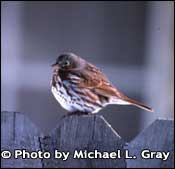
Fox Sparrow
Photo Copyright Michael L. Gray
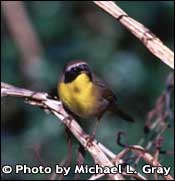
Common yellowthroat
Photo Copyright Michael L. Gray
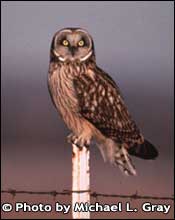
Short-eared owl
Photo Copyright Michael L. Gray

American robin (AMRO)
Photo Copyright Michael L. Gray
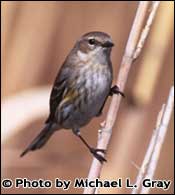
Yellow-rumped warbler (YRWA)
Photo Copyright Michael L. Gray
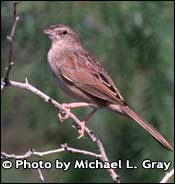
Botteri's sparrow
Photo Copyright Michael L. Gray
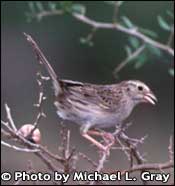
Cassin's sparrow
Photo Copyright Michael L. Gray
For a complete list of alpha codes, see: the Patuxent Wildlife Research Center Complete Species List.
Project Prairie Birds Program
Texas Parks and Wildlife Department
4200 Smith School Road
Austin, TX 78744
or send a message to: nature@tpwd.state.tx.us